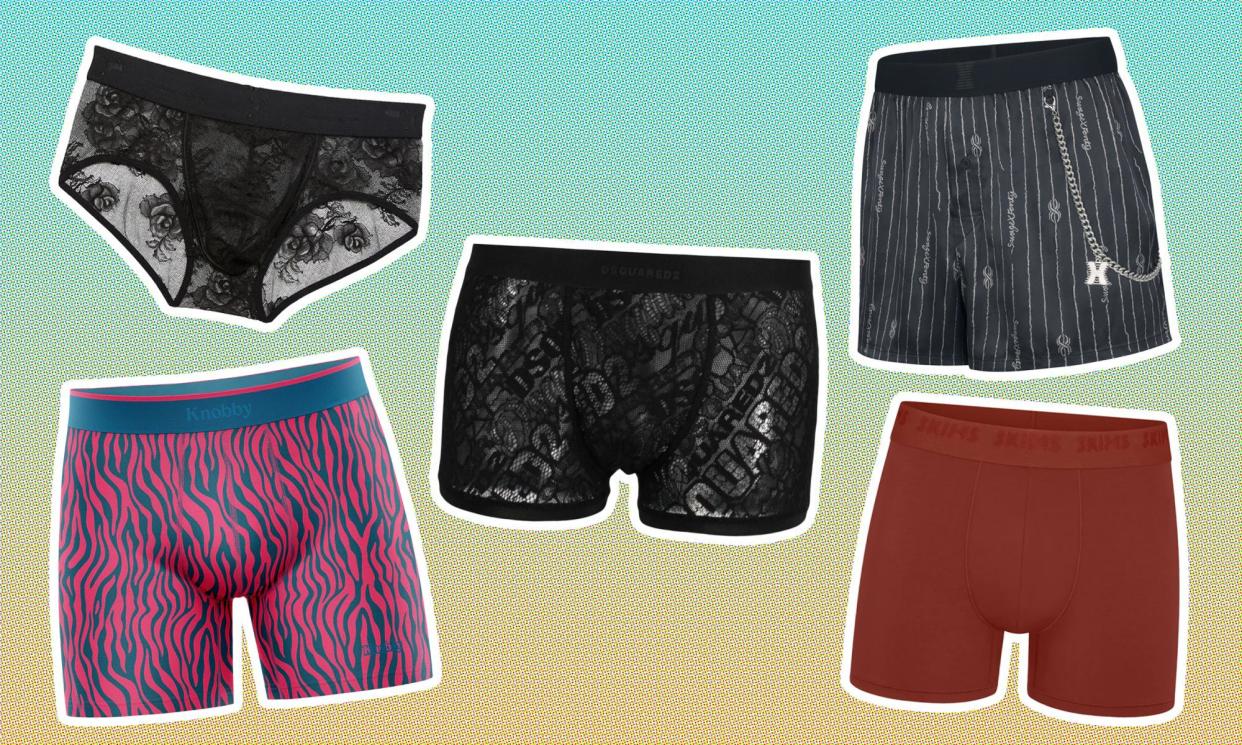‘The ultimate show of confidence’: after years of boring briefs men’s underwear takes a sexier turn

From Jacob Elordi’s collection of purses to Troye Sivan’s love of corsets and Harry Styles’ sequin onesie, men’s fashion has been trending towards fluidity for several years. In January it led to the delightful term of endearment “so babygirl” – a reference to an attractive man with cute style. Now it has spread to what’s beneath: playful men’s underwear is having a moment.
Whether it’s magenta print trunks or logo-embroidered lace, after a long period when men’s options didn’t get much more exciting than striped boxer briefs, things in the underwear department have shifted.
Max Thomas Sanderson, a tailor who teaches fashion design at Parsons Paris, welcomes the expansion “beyond what was previously considered attractive or appropriate for men”, saying it allows for more creative and empowering choices.
Jennifer Zuccarini, the founder of the US lingerie and ready-to-wear brand Fleur du Mal, sells the most extensive (and expensive) range of lace underwear for men.
She says her customers are drawn to the novelty factor, “or something a bit out of their comfort zone”. Many of her male clients shopped for their partners, and liked the idea of having something new to try too. “I also hear from men that wearing lace or silk makes them feel sexier,” she says. “It’s pretty similar to what we hear from the women who shop with us.”
Related: Readers reply: why do we wear underwear – and when did we start doing so?
Fleur du Mal’s shapes are mostly taken from the classics, including boxer briefs made from black mesh with a rose motif – double-layered at the pouch for support – which retail for $250. It also makes a thong with the brand’s signature lily embroidery across the waist ($160) and a unisex sheer tank top made from the black rose mesh ($495).
Rihanna’s much more affordable lingerie brand Savage X Fenty makes velvet jockstraps ($19.95) and chain-embellished boxers ($49.95), while Kim Kardashian’s Skims and the Australian direct-to-consumer startup Knobby both sell men’s briefs in similar fabrics and palettes to their women’s lines (from $30 and $32, respectively). At the low end of the price spectrum, Shein and Temu are selling men’s lace underwear for as little as $6.95 and $3.66. The embrace of ultra-fast fashion brands – however fleeting – is evidence that a trend has taken off.
The difference in male and female anatomy, and the performance attributes required for functional men’s underwear, presented Fleur du Mal’s design team with a challenge. “Men need a completely different construction for fit and support,” Zuccarini says. The designers had to seek out fabrics with stretch, that were not overly delicate, while still being pretty enough to properly fill the brief.
Similarly, Fleur du Mal realised its care instructions needed to fit their new demographic’s preferences. “One thing we are working on is creating more machine-washable styles,” Zuccarini says. “Most men are not well versed in hand washing.”
While menswear is often associated with an austere and pared-back aesthetic, this has not always been the case. “In previous eras, men’s clothing was far more elaborate and playful than typical menswear today,” Sanderson says. “The idea of lace being something feminine or solely for women is a relatively recent historical occurrence.”
In the more immediate past, gender norms have been relaxing, morphing and blurring, within and outside fashion. As these changes trickle down, according to the designer and stylist Pascal Mihranian, “modern-day male celebrities and role models seem to be less afraid to borrow from queer codes”.
On the Wonka press tour last year Timothée Chalamet wore a look from Tom Ford’s women’s spring/summer 2024 collection; at the Golden Globes in January Pedro Pascal’s outfit was inspired by another women’s spring/summer 2024 look, from Bottega Veneta. At this week’s Emmy awards Tyler James Williams showed off his arms in a sleeveless Gucci shirt and wore diamond cuff bracelets.
Zuccarini says when male celebrities wear more feminine styles or accessories, “it doesn’t necessarily make them appear less masculine”. Instead, “it’s almost the ultimate show of confidence and self-expression,” she says. “This reflects how comfortable these men are in their own skin.”
The designer, stylist and performer Brendan de la Hay says: “No matter whether heterosexual, bisexual, pansexual, queer, gender fluid, non-binary or just good ol’ femme presenting, there are plenty of men who have always been infatuated by the fabric we place on our bodies and not afraid to express themselves through lingerie.”
Thanks to social media, De la Hay says, mainstream brands are catching on to boundary-pushing styles once available only in secret, or within young, queer designers’ immediate networks.
Visibility can be a double-edged sword. “The importance of underwear increases as it is more likely to be seen,” Mihranian says. More extensive underwear options suggest more men are being subjected to “beauty standards and the pressure to appear attractive” – a pressure that has always been there for women, he notes.
For their part, De la Hay thinks fashion’s next step could be to “eliminate terminology like ‘men’ and ‘women’ from the shopping experience all together”.
“It’s clothing on a body, babe. It doesn’t have a gender.”


